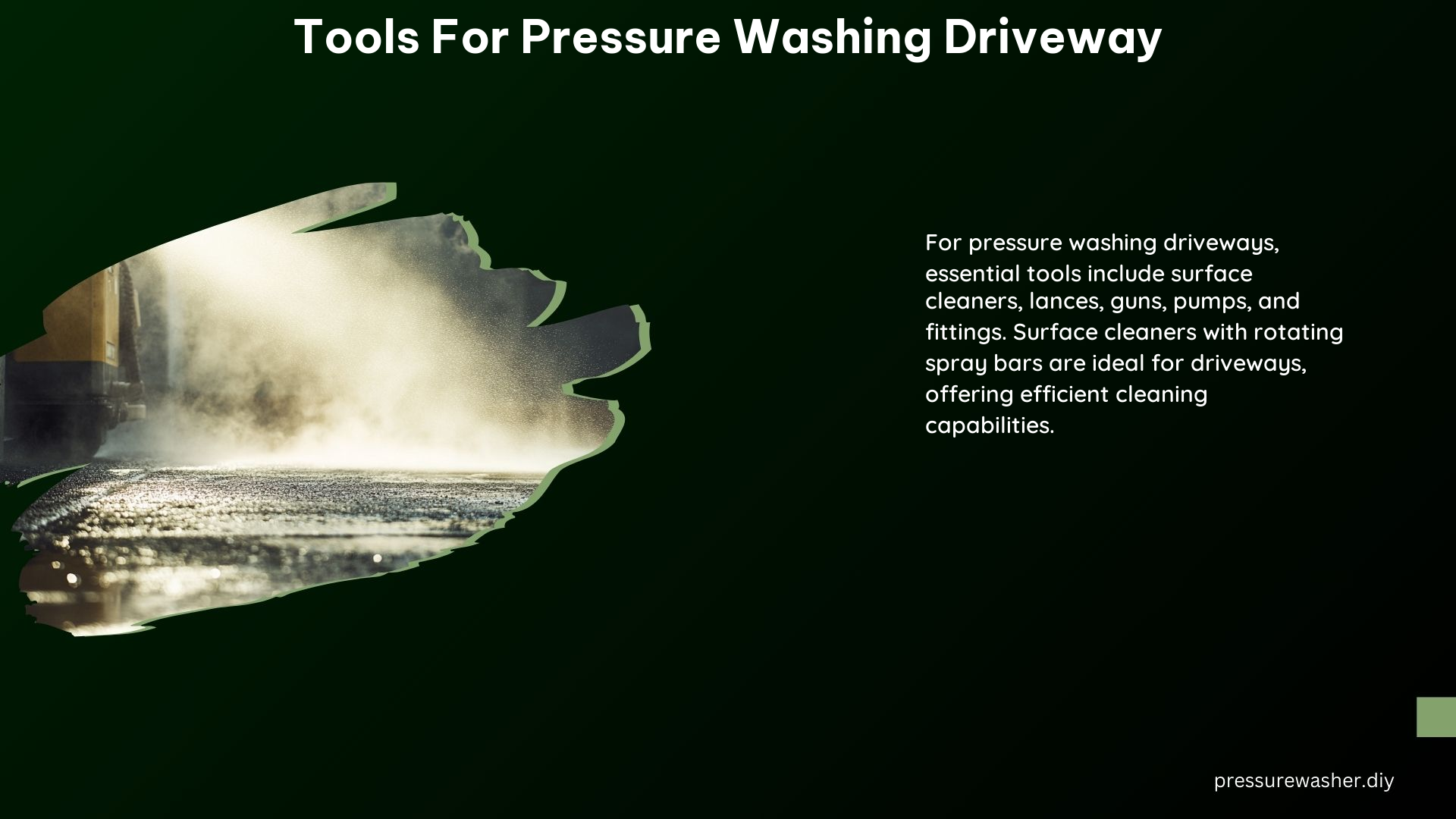Pressure washing is an effective way to clean and restore the appearance of driveways, but the success of the task depends on the right tools and techniques. This comprehensive guide delves into the key tools for pressure washing driveways, their technical specifications, and essential DIY considerations to ensure a successful and safe cleaning process.
Key Tools for Pressure Washing Driveways
Surface Cleaners
Surface cleaners are round tools with internal rotating spray bars that deliver a wide, circular pattern of high-pressure water. These are particularly well-suited for cleaning large areas like driveways. Some popular models include the 14″ Pressure Washer Surface Cleaner with 4 Wheels and the Kärcher 3200 PSI Universal Surface Cleaner Attachment.
These surface cleaners typically feature the following specifications:
– Cleaning Path Width: 12-18 inches
– Pressure Rating: 2,000-4,500 PSI
– Flow Rate: 2-5 GPM
– Adjustable Spray Pattern: 0°, 15°, 25°
– Durable Construction: Stainless steel or aluminum
The rotating spray bars and wide cleaning path allow for efficient and uniform coverage of the driveway surface, saving time and effort compared to using a standard pressure washer wand.
Pressure Washer Machines
Industrial-grade pressure washers, such as the Slipstream™ professional models, are designed for heavy-duty cleaning tasks, including driveways. These machines offer high cleaning power capabilities and are suitable for a variety of driveway surfaces, including concrete, block paving, and more.
Key specifications to consider for pressure washers suitable for driveway cleaning:
– Pressure Rating: 2,000-4,500 PSI
– Flow Rate: 2-5 GPM
– Engine/Motor Power: 4-7 HP (gas-powered) or 1.5-2.5 HP (electric)
– Hose Length: 25-50 feet
– Portability: Wheel-mounted or trailer-mounted for easy maneuverability
The high pressure and flow rate of these professional-grade pressure washers ensure efficient and thorough cleaning of even the toughest driveway stains and grime.
Lances and Guns
Lances and guns are used to direct the high-pressure water stream onto the driveway surface. They come in various lengths and styles, such as extension wands, to facilitate cleaning hard-to-reach areas.
Some key features of pressure washer lances and guns include:
– Adjustable Spray Patterns: 0°, 15°, 25°, 40°
– Ergonomic Design: Comfortable grip and trigger
– Corrosion-Resistant Materials: Stainless steel or brass
– Quick-Connect Fittings: For easy attachment to the pressure washer
The ability to adjust the spray pattern and reach difficult areas with extension wands allows for targeted and effective cleaning of the driveway.
Pumps and Fittings
Pumps are the essential components of pressure washers, providing the necessary pressure to clean surfaces effectively. Fittings, such as quick-connectors and hoses, are used to connect the various components of the pressure washer system.
Key pump and fitting specifications include:
– Pump Type: Axial, triplex, or wobble-plate
– Pump Material: Brass, stainless steel, or aluminum
– Hose Diameter: 1/4″ to 3/8″
– Quick-Connect Fittings: Brass or stainless steel
The quality and compatibility of the pumps and fittings are crucial for ensuring the optimal performance and longevity of the pressure washer system.
Technical Specifications

Pressure Rating
Pressure washers for driveways typically operate at high pressures, ranging from 2,000 to 4,500 PSI (pounds per square inch). The higher the pressure, the more effective the cleaning power, but it’s essential to choose a pressure washer that matches the driveway surface material to avoid damage.
Flow Rate
The flow rate of a pressure washer, measured in gallons per minute (GPM), affects the cleaning efficiency. Common flow rates for driveway cleaning range from 2 to 5 GPM. Higher flow rates can cover more area in less time, but they also require more water supply.
Nozzle Size and Type
Nozzle sizes and types vary depending on the specific cleaning task. For driveways, larger nozzles (e.g., 0°, 15°, 25°) are often used to cover more area and distribute the water more evenly. The choice of nozzle size and type can significantly impact the cleaning performance and efficiency.
DIY Considerations
Safety
When operating a pressure washer, it’s crucial to prioritize safety. Always wear protective gear, including gloves, safety glasses, and a face mask, to prevent injury from the high-pressure water stream.
Surface Preparation
Before pressure washing the driveway, clear the area of any debris, loose objects, or vegetation to prevent damage or injury during the cleaning process.
Chemical Selection
Choose the appropriate cleaning solution for the driveway surface, taking care not to damage the material. Some common driveway cleaning solutions include detergents, degreasers, and concrete cleaners. Always follow the manufacturer’s instructions for proper dilution and application.
References
- https://www.spinaclean.com/industrial-pressure-washers
- https://www.homedepot.com/b/Outdoors-Outdoor-Power-Equipment-Pressure-Washers/Driveway/N-5yc1vZbxbeZ1z1c6kw
- https://www.cleanprosupply.com/pressure-washing-equipment-tools/
- https://www.angi.com/articles/guide-to-pressure-washer-attachments-driveways.htm
- https://www.amazon.com/driveway-pressure-washer-attachment/s?k=driveway+pressure+washer+attachment
